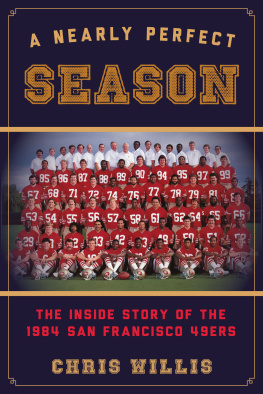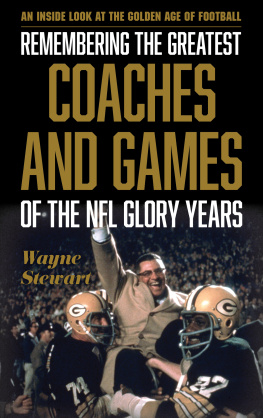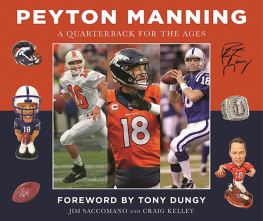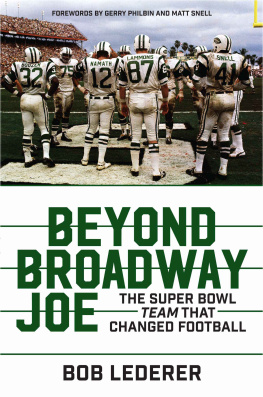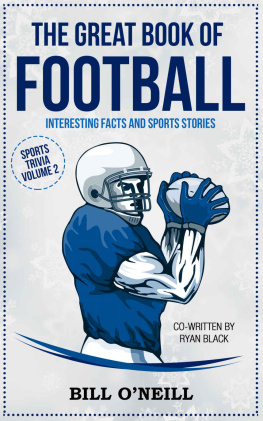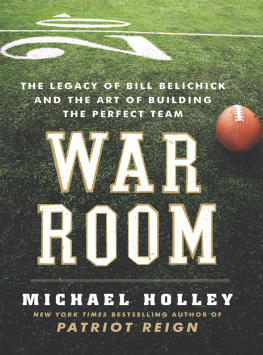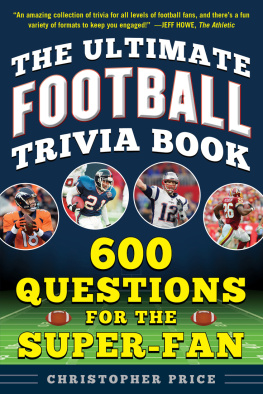
To my wife, Eileen, and our children and grandchildren. Thanks for the sacrifice that allowed me to live a football life. I love you all. To Vic Carucci, my friend of over three decades, who did all the heavy lifting on this book. What a joy it is to work with you.
Bill Polian
To the Carucci familys incredible collection of bright lights that bring a smile to Pops face every day: Emma, Logan, Victor, and Oliver, who arrived just in time to be a part of this dedication. I love you with all my heart.
Vic Carucci
Contents
Introduction
In planning this book, Vic and I thought we could do a wide-ranging look at the NFLs best teams. We soon found out that was impossible.
Too much ground to cover, too little space.
Two teams not included are the Don Shula (Perfect) Miami Dolphins and the Bill Belichick New England Patriots. This is an oral history and the voices of Coach Shula, the driving force behind the Dolphins; their personnel director, George Young; and many key players, like Nick Buoniconti, are regrettably no longer with us. We couldnt do this great team justice without them.
The key Patriots of the dynasty, Coach Belichick and Tom Brady, are still looking to add to their incredible legacies and their story is a book unto itself. We will appropriately leave that to others.
The 1985 Chicago Bears, under Hall of Famer Mike Ditka and Buddy Ryan, and the 199899 Denver Broncos, under Bill Walshdisciple Mike Shanahan and with Hall of Famer John Elway running essentially West Coast III, were also worthy subjects. Unfortunately, like in football, the publishing business doesnt allow you to cover everything you want.
We had no interest in ranking teams, so whoever your favorite team of all time might beyoure right! We have no wish to join that conversation.
As we dove more deeply into this project, a clear picture emerged. From 1975 through 1997, a small number of franchisesled by committed ownership, Hall of Fame general managers, and most importantly, charismatic coaches who created systems of football that had lasting effects on the NFLcontrolled the leagues landscape.
Bill Walsh and his West Coast offense, aided by his successor George Seifert, won five Super Bowls with San Francisco. Walshs disciple, Mike Holmgren, brought West Coast II and a title to Green Bay.
The NFC East was dominant and incredibly competitive during this period. Joe Gibbs brought the one-back offense to the NFL and won three Super Bowls with Washington. Jerry Jones and Jimmy Johnson reinvented the Dallas Cowboys, and behind offensive tripletsEmmitt Smith, Troy Aikman, and Michael Irvinwon three Super Bowls as well. Bill Parcells brought the 3-4 power defense and a power run game to the New York Giants and garnered two Lombardi trophies.
In the AFC, Chuck Noll and the Steel Curtain Cover Two defense won four Super Bowls. Al Davis, Tom Flores, and the Raiders long-ball offense won two. And Marv Levys no-huddle attack went to an unprecedented four straight Super Bowls. They lost to the Giants, Washington, and then Dallas twice.
We decided to add the Tony DungyPeyton Manning Indianapolis Colts. They won 115 games from 2000 to 2009 and appeared in two Super Bowls, winning one. Former Giants quarterback Phil Simms pointed out that Peyton changed how quarterback was played at every level because he was totally in control of a no-huddle offense at the line of scrimmage.
All of these teams had outstanding GMs who put the personnel in place. Chuck Noll and Bill Walsh were essentially their own GMs. Al Davis, with a big assist from Ron Wolf, ruled the Raiders, and Wolf teamed up with Holmgren to resuscitate Green Bay.
Jimmy Johnson brought great personnel acumen to the Cowboys, while Jerry Jones did the wheeling and dealing. George Young and Bobby Beathard, as personnel directors, both played a major role in building Shulas Dolphins. They then went on to prominence as the architects of the Super Bowl Giants and Redskins, respectively. Charley Casserly succeeded Beathard in Washington and continued the run of excellence. I honed my craft with Marv Levy in Buffalo and later had the good fortune to team up with Tony Dungy in Indianapolis.
Davis, Flores, Noll, Walsh, Gibbs, Beathard, Parcells, Young, Jones, Johnson, Levy, Wolf, and yours truly are in the Pro Football Hall of Fame.
This oral history is told through the voices of those who participated. You will, as we did, hear things that astound you and things that will bring tears to your eyes. Most of all, you will hear the stories of these legendary teams from the inside.
History from those who made it.
We hope you enjoy reading it as much as we enjoyed its production.
Bill Polian
1. The Architect, Al Davis, and The Greatness of the Raiders
Ive always felt that the Oakland Raiders had a lot to do with the development of the Pittsburgh Steelers in the 70s, because they were a tough, physical football team. Every game was a war. If you were going to compete with them, you had to be better.
And that didnt just go for us. If you look at the history, the Jets had to go through the Raiders to get to the Super Bowl, Kansas City had to go through the Raiders to get to the Super Bowl, the Baltimore Colts had to go through the Raiders to get to the Super Bowl.
They were always the gatekeepers.
Joe Greene, Pittsburgh Steelers Hall of Fame defensive end
Bill Polian: In 1963, a young and relatively unknown receivers coach for the American Football League champion San Diego Chargers became head coach (and de facto GM) of the downtrodden Oakland Raiders. His name, Al Davis, would become synonymous with the franchise. Al laid the foundation for what he termed the greatness of the Raiders.
In 1966, he departed to become commissioner of the AFL. His audacious and aggressive tactics in signing NFL players to huge futures contracts soon forced the AFL-NFL merger. Al was bypassed as commissioner of the newly merged leagues in favor of NFL commissioner Pete Rozelle, a slight he never forgot. He returned to the Raiders as managing general partner and built the team into a three-time Super Bowl champion and one of the NFLs most iconic franchises.
In addition to drafting and signing many Hall of Fame players, Al hired Hall of Fame coaches John Madden and Tom Flores, as well as Hall of Fame talent evaluator and Super Bowlwinning GM Ron Wolf. He also made history by hiring the first African American head coach in the modern history of the NFL, Art Shell, a Hall of Fame offensive tackle for the Raiders.
Until the end of his life, Al was a force to be reckoned with on and off the field in the NFL. He moved the Raider franchise twice from Oakland to Los Angeles and back to Oakland, before their ultimate move to Las Vegas after his passing. He engaged in numerous court battles over those moves in the process, creating new law and new franchise-movement standards for the NFL.
Often portrayed as a renegade, Al was at heart a football man who believed in the preeminence of his franchise. He is, without question, one of the most celebrated and impactful drivers of professional football in history.
Wolf, Flores, and Hall of Fame cornerback Mike Haynes take you behind the scenes of Al Davis Raiders.
Ron Wolf: I went to work for the Raiders in May 1963, not long after I took my last final at the University of Oklahoma. In 1962, I worked briefly for Pro Football Illustrated , the forerunner to Pro Football Weekly , a publication based in Chicago. The editor, Ted Albert, happened to be in San Francisco when Al was named head coach and general manager of the Oakland Raiders. Ted was there to interview Al and Al mentioned he was looking for somebody in his personnel department who knew the names of college players. Ted recommended me.


